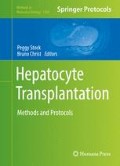Abstract
Hepatocyte transplantation is the best approach to maintain and propagate differentiated hepatocytes from different species. Host liver has to be adapted for transplanted hepatocytes productive engraftment and proliferation being required a chronic liver injury to eliminate host hepatocytes and provide a proliferative advantage to the transplanted hepatocytes. Most valuable mouse models for xenograft hepatocyte transplantation are based on genetically modified animals to cause a chronic liver damage and to limit host hepatocyte regeneration potential. We present a methodology that generates a chronic liver damage and can be applied to any host mouse strain and animal species based on the inoculation of a recombinant adenovirus to express herpes simplex thymidine kinase in host hepatocytes sensitizing them to ganciclovir treatment. This causes a prolonged liver damage that allows hepatocyte transplantation and generation of regenerative nodules in recipient mouse liver integrated by transplanted cells and host sinusoidal. Obtained chimeric animals maintain functional chimeric nodules for several weeks, ready to be used in any study.
Access this chapter
Tax calculation will be finalised at checkout
Purchases are for personal use only
References
Elaut G, Henkens T, Papeleu P et al (2006) Molecular mechanisms underlying the dedifferentiation process of isolated hepatocytes and their cultures. Curr Drug Metab 7:629–660
De Bruyn T, Chatterjee S, Fattah S et al (2013) Sandwich-cultured hepatocytes: utility for in vitro exploration of hepatobiliary drug disposition and drug-induced hepatotoxicity. Expert Opin Drug Metab Toxicol 9:589–616
Fraczek J, Bolleyn J, Vanhaecke T et al (2013) Primary hepatocyte cultures for pharmaco-toxicological studies: at the busy crossroad of various anti-dedifferentiation strategies. Arch Toxicol 87:577–610
Gomez-Lechon MJ, Tolosa L, Conde I et al (2014) Competency of different cell models to predict human hepatotoxic drugs. Expert Opin Drug Metab Toxicol 10:1553–1568
Aldabe R, Suarez-Amaran L, Usai C et al (2015) Animal models of chronic hepatitis delta virus infection host-virus immunologic interactions. Pathogens 4:46–65
Iannacone M, Guidotti LG (2015) Mouse models of hepatitis B virus pathogenesis. Cold Spring Harb Perspect Med 5. 10.1101/cshperspect.a021477
Vercauteren K, de Jong YP, Meuleman P (2015) Animal models for the study of HCV. Curr Opin Virol 13:67–74
Jaiswal S, Sharma A, Shukla M et al (2014) Novel pre-clinical methodologies for pharmacokinetic drug-drug interaction studies: spotlight on “humanized” animal models. Drug Metab Rev 46:475–493
Scheer N, Wilson ID (2016) A comparison between genetically humanized and chimeric liver humanized mouse models for studies in drug metabolism and toxicity. Drug Discov Today 21:250–63
Kosaka K, Hiraga N, Imamura M et al (2013) A novel TK-NOG based humanized mouse model for the study of HBV and HCV infections. Biochem Biophys Res Commun 441:230–235
Grompe M, Strom S (2013) Mice with human livers. Gastroenterology 145:1209–1214
Douglas DN, Kneteman NM (2015) Generation of improved mouse models for the study of hepatitis C virus. Eur J Pharmacol 759:313–325
Sangro B, Mazzolini G, Ruiz M et al (2010) A phase I clinical trial of thymidine kinase-based gene therapy in advanced hepatocellular carcinoma. Cancer Gene Ther 17:837–843
Moreno D, Balasiddaiah A, Lamas O et al (2013) Usage of adenovirus expressing thymidine kinase mediated hepatocellular damage for enabling mouse liver repopulation with allogenic or xenogenic hepatocytes. PLoS One 8:e74948
Balasiddaiah A, Moreno D, Guembe L et al (2013) Hepatic differentiation of mouse iPS cells and analysis of liver engraftment potential of multistage iPS progeny. J Physiol Biochem 69:835–845
Duret C, Moreno D, Anangi B et al (2015) Cold-preservation of human adult hepatocytes for liver cell therapy. Cell Transplant. [Epub Ahead of Print]
Caselmann WH (1994) HBV and HDV replication in experimental models: effect of interferon. Antiviral Res 24:121–129
Martin PL, Weinbauer GF (2010) Developmental toxicity testing of biopharmaceuticals in nonhuman primates: previous experience and future directions. Int J Toxicol 29:552–568
Crettaz J, Otano I, Ochoa-Callejero L et al (2009) Treatment of chronic viral hepatitis in woodchucks by prolonged intrahepatic expression of interleukin-12. J Virol 83:2663–2674
van Rijn RS, Simonetti ER, Hagenbeek A et al (2003) A new xenograft model for graft-versus-host disease by intravenous transfer of human peripheral blood mononuclear cells in RAG2-/- gammac-/- double-mutant mice. Blood 102:2522–2531
Viswanathan P, Kapoor S, Kumaran V et al (2014) Etanercept blocks inflammatory responses orchestrated by TNF-alpha to promote transplanted cell engraftment and proliferation in rat liver. Hepatology 60:1378–1388
Author information
Authors and Affiliations
Corresponding author
Editor information
Editors and Affiliations
Rights and permissions
Copyright information
© 2017 Springer Science+Business Media New York
About this protocol
Cite this protocol
Moreno, D., Neri, L., Vicente, E., Vales, A., Aldabe, R. (2017). Use of Thymidine Kinase Recombinant Adenovirus and Ganciclovir Mediated Mouse Liver Preconditioning for Hepatocyte Xenotransplantation. In: Stock, P., Christ, B. (eds) Hepatocyte Transplantation. Methods in Molecular Biology, vol 1506. Humana Press, New York, NY. https://doi.org/10.1007/978-1-4939-6506-9_12
Download citation
DOI: https://doi.org/10.1007/978-1-4939-6506-9_12
Published:
Publisher Name: Humana Press, New York, NY
Print ISBN: 978-1-4939-6504-5
Online ISBN: 978-1-4939-6506-9
eBook Packages: Springer Protocols

